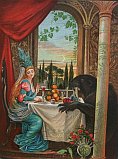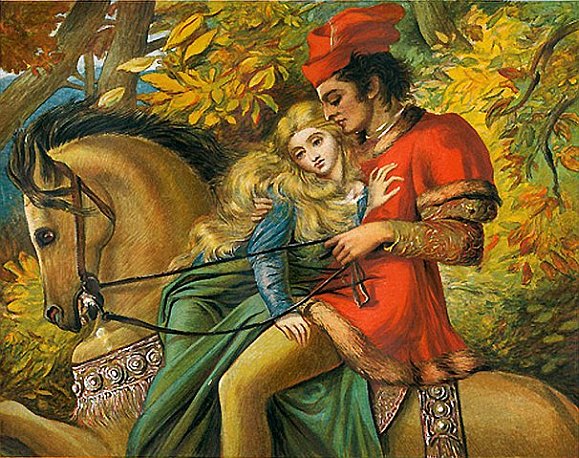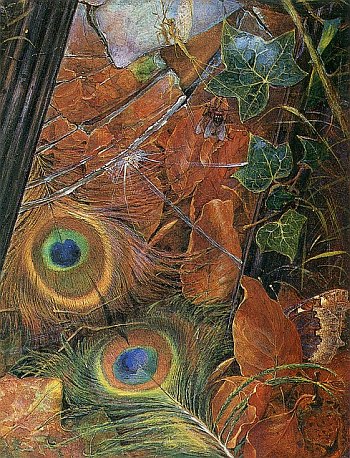Eleanor Vere Boyle was a painter and illustrator whose arresting technique was influenced by the pre-Raphaelites. Her best works were simultaneously moody, immensely detailed, and haunting. Dante Gabriel Rosetti admired her art, and called her “great in design.” She is one of the earliest woman artists to be recognized for her achievements, although she kept a low profile, and rarely exhibited her work publicly. Selling her paintings or illustrations was not considered acceptable, given her family’s social standing, and throughout her life she signed her works, “EVB,” obscuring her identity.
She was born in Scotland, and portraits of her show a slight, exquisitely beautiful young woman, with striking sea-blue eyes. Eleanor was from an old and landed family, descended on her mother’s side from the third Earl of Aberdeen (albeit on the wrong side of the blanket). The Veres, her father’s family, were descendants of the Duke of Ancaster. She married Richard Boyle, a younger son of the eighth Earl of Cork. He served as chaplain to Queen Victoria. (Eleanor and Richard may well have met at Hampton Court, a residence of the royal family where Eleanor’s grandmother was a lady-in-waiting.)
Eleanor was said by her contemporaries to have had a bright and merry personality. She was witty, a wonderful conversationalist and, according to her grandson, Captain Edmund Boyle, had a sparkling and delicate sense of humor. Inwardly though, perhaps from being brought up in the solitude of the Scottish hills above the River Dee, the youngest of eight children, there was a “darker streak, a tinge of Gaelic mysticism which gives a slightly sinister character to some of her pictures.” She was preoccupied with fate, nature; dreams, flowing water and fountains, and those interests infuse her illustrations.
This is clear in works such as her illustrations for Tennyson’s May Queen, which she illustrated for the poet in 1852 and Carove’s Story Without an End in 1868. It is particularly evident in her illustrations for Fairy Tales by Hans Andersen. This 1872 edition of Andersen is one of the earliest illustrated by an English person. It is certainly one of the most magnificent. It was produced by Sampson Low, Marston, Low, and Searle as a large folio and included 12 full color plates and many evocative line drawings. The pre-Raphaelite Renaissance atmosphere is marked in all the illustrations, and is perhaps especially striking in those for ‘The Wild Swans,’ ‘Thumbkinetta,’ ‘The Snow Queen,’ and ‘The Angel.’ Hans Andersen had a definite dark side to many of his stories, and EVB’s ability to translate that into visual form can be seen clearly in an illustration for the story ‘The Fellow-Traveller.’ Not a well-known Andersen story today, the tale takes threads from folk tales and myths such as the riddles of the sphinx. Tolkien drew on this tradition when he wrote the scenes of Bilbo the Hobbit trading riddles in the dark with Gollum. Here, the young hero peers into the eerie garden of a Wicked Princess where there is strange fruit hanging in the trees. The skeletons of all the suitors who have sought her hand, but failed to guess her riddles, dangle above poisonous plants potted in skulls.
EVB’s masterpiece, however, may be her retelling and illustration of the story of Beauty and the Beast. This was produced by Sampson, Low, et al in 1875. It has ten full color illustrations, the best of which are singular for their “theatrical poses, Renaissance drapery, and interiors framed with arches and columns.” Eleanor’s representation of the Beast is unique. This classic tale, with echoes of the Greek myth of Cupid and Psyche, has been illustrated many times. Yet only EVB’s monster seems to be a sea-creature, with walrus or seal-like characteristics and flippers. Most illustrators portray the beast upright, in a human pose. He may be an amalgam of animals: a beast with a lion’s body and an eagle head, for example. He may be a single animal, such as a lion or bear. Almost always clothed, often richly. There is some relationship that can be seen to a human being.
Eleanor’s beast has no human features to face or body, no hint of a human glint of eye. One scene of Beauty’s bedchamber shows rich panels of sea creatures. Is EVB hinting here at the ancient myths of the shape-changing selkies? Those Celtic sea-beings could be either male or female, and changed from seal to human by taking off their seal skins to walk out of the ocean and seek human mates. Whether or not this shape-change myth influenced her characterization of the Beast, her marvelous scenes, with their charged interplay of light and dark, are sometimes said to have anticipated Jean Cocteau’s 1946 film of Beauty and the Beast in their “treatment of light and dark, illusion to reality.”
EVB was an active artist and writer throughout her long life. In her later years, she primarily wrote and illustrated garden books, and her last book, The Peacock’s Pleasaunce, was published by John Lane in 1908, when she was 83. By the time of her death, she had written or illustrated 21 books.




{ 0 comments… add one now }